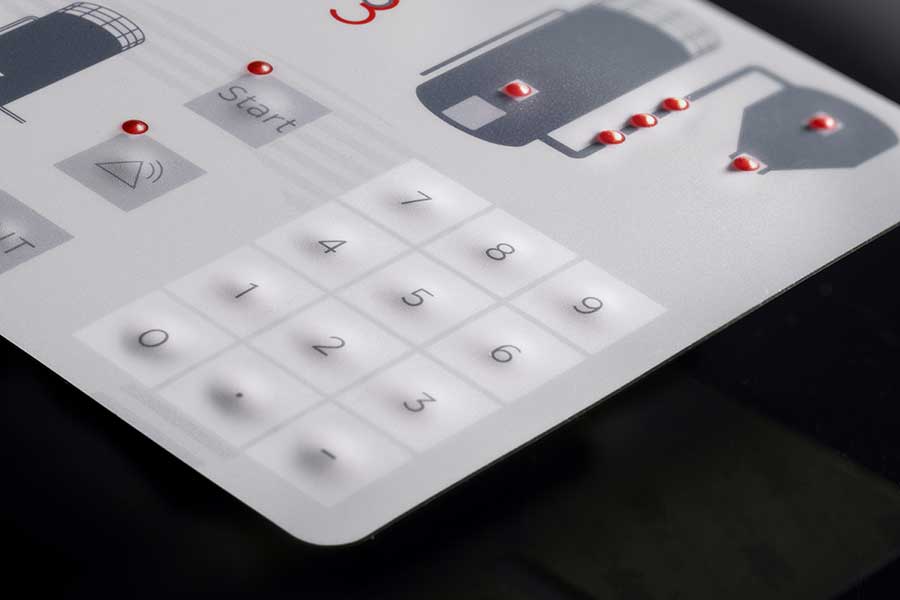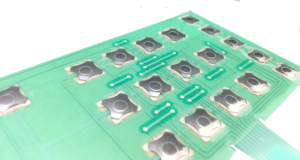How Membrane Layer Switches Contribute to the Longevity of Electronic Control Panels
Membrane switches play a crucial duty in boosting the toughness of electronic control board, mainly through their multi-layered construction which offers reliable security versus environmental elements such as wetness and dirt. This layout not just lessens the threat of circuit damage and corrosion however additionally advertises simplicity of maintenance as a result of its smooth surface. The lack of relocating components considerably minimizes the chance of mechanical failings, making membrane layer switches over suitable for requiring applications. Nonetheless, the effects of these features extend beyond mere defense, questioning concerning their broader influence on functionality and user experience.
Definition of Membrane Layer Switches

Membrane layer buttons are designed to be slim and light-weight, making them ideal for applications where space is limited. They can be manufactured in different forms, dimensions, and shades, offering flexibility in layout that satisfies visual and practical demands. In addition, membrane layer buttons can include various innovations, such as responsive feedback and LED indicators, enhancing user experience.
Because of their building and construction, membrane buttons are frequently resistant to dust, moisture, and basic wear, adding to their resilience in demanding atmospheres. Their smooth design not just assists in easy cleaning however additionally reduces the risk of mechanical failing, making them a preferred option for makers looking for trusted customer interfaces in their digital control board.
Security Versus Ecological Aspects
The design of membrane layer changes inherently provides a level of defense against different ecological aspects, which is important for preserving performance in difficult problems - Membrane Switch. These switches are normally constructed with layers of versatile materials that shield interior elements from moisture, dirt, and impurities. By encapsulating the wiring, membrane layer switches over reduce the threat of brief circuits and deterioration, which can significantly impair efficiency
Additionally, using robust adhesives and sealants during manufacturing boosts their resistance to ecological obstacles. Membrane layer switches can sustain exposure to chemicals and solvents, making them appropriate for industries such as food handling and health care, where hygiene and cleanliness are paramount. Their seamless surface area layout additionally stops the build-up of dust and bacteria, helping with much easier cleaning and maintenance.
Temperature variations are one more environmental my response worry, and membrane layer switches are engineered to function properly across a vast array of temperatures (Membrane Switch). This versatility ensures that control panels stay functional in different setups, from commercial environments to customer electronics
Impact on Customer Interaction
User interaction with electronic control board is considerably influenced by the layout and functionality of membrane buttons. These buttons offer a responsive interface that enhances the general individual experience, permitting for user-friendly navigation and control. Their responsive nature ensures that users obtain immediate comments upon activation, which is important for tasks calling for precision and performance.
Moreover, the smooth surface of membrane layer changes promotes simple cleansing and upkeep, advertising customer confidence in the reliability of the interface. This tidiness is specifically vital in atmospheres where health is extremely important, such as medical or food processing setups. In addition, the portable and light-weight style of membrane layer changes contributes to the aesthetic appeal of control panels, encouraging user engagement with a modern and sleek look.
Moreover, the combination of aesthetic components, such as printed symbols and backlighting, helps individuals rapidly identify functions, decreasing the finding out curve connected with new devices. Consequently, individuals can run devices a lot more successfully, causing raised efficiency and complete satisfaction. In summary, membrane layer buttons play an essential function in enhancing individual interaction by combining capability, appearances, and simplicity of use, inevitably causing improved functional efficiency.
Layout Versatility and Customization
Style adaptability and personalization are important facets of membrane buttons, enabling producers to customize digital control panels to certain applications and user demands. This adaptability permits for the assimilation of numerous style components, such as colors, graphics, and appearances, which can boost the visual charm and customer engagement of the control board.
Membrane layer switches can be tailored in size and form, accommodating a large variety of devices and applications, from commercial equipment to customer electronics. This convenience guarantees that makers can develop intuitive interfaces that straighten with user assumptions and operational requirements. In addition, the ability to incorporate special attributes such as backlighting or the original source responsive responses even more boosts usability, allowing for a much more interactive experience.
Additionally, the manufacturing procedure for membrane layer switches supports the rapid prototyping of styles, allowing makers to repeat and improve their concepts quickly. This capability not only accelerates the development timeline yet additionally ensures that the end product fulfills particular functional and visual standards.

Cost-Effectiveness and Long Life
Cost-effectiveness and long life are substantial advantages of membrane layer buttons, making them an appealing choice for producers and end-users alike. These switches are typically Click Here less costly to create than standard mechanical buttons, largely because of their simplified production processes and the decreased number of parts needed. This cost advantage prolongs not only to preliminary production yet likewise to long-term operational costs, as membrane layer buttons typically require much less maintenance and have a lower failing rate.
Moreover, the long life of membrane layer switches adds to their general worth. Built from long lasting materials, they are immune to environmental variables such as wetness, dirt, and chemicals, which can result in premature wear in various other switch kinds. The absence of relocating components decreases mechanical failing, allowing membrane layer switches to preserve capability over prolonged durations.
This longevity is especially advantageous in applications calling for consistent efficiency under requiring conditions, such as medical tools and industrial tools. Inevitably, the combination of cost-effectiveness and long life makes membrane layer switches a financially feasible option for makers, offering trusted services that endure the test of time while optimizing budgetary factors to consider.
Conclusion
In verdict, membrane switches dramatically improve the longevity of electronic control panels through their robust building and protective functions - Membrane Switch. On the whole, membrane layer changes represent a reliable and cost-efficient choice for improving the long life and functionality of digital control systems.